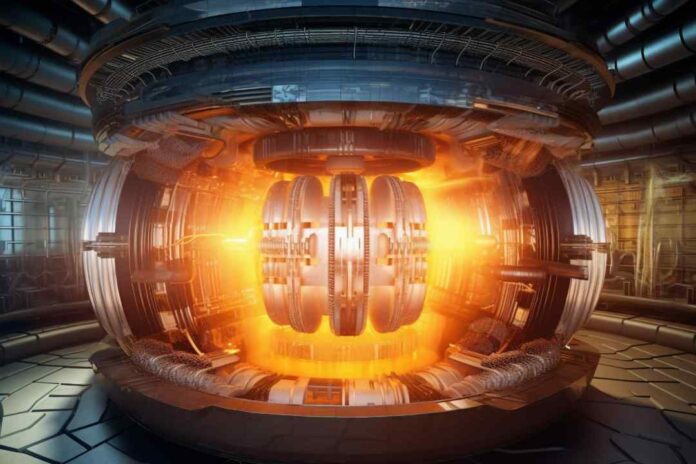University of Wisconsin–Madison engineers have used a spray coating technology to produce a new workhorse material that can withstand the harsh conditions inside a fusion reactor.
The advance, detailed in a paper published recently in the journal Physica Scripta, could enable more efficient compact fusion reactors that are easier to repair and maintain.
“The fusion community is urgently looking for new manufacturing approaches to economically produce large plasma-facing components in fusion reactors,” says Mykola Ialovega, a postdoctoral researcher in nuclear engineering and engineering physics at UW–Madison and lead author on the paper. “Our technology shows considerable improvements over current approaches. With this research, we are the first to demonstrate the benefits of using cold spray coating technology for fusion applications.”
The researchers used a cold spray process to deposit a coating of tantalum, a metal that can withstand high temperatures, on stainless steel. They tested their cold spray tantalum coating in the extreme conditions relevant to a fusion reactor and found that it performed very well. Importantly, they discovered the material is exceptionally good at trapping hydrogen particles, which is beneficial for compact fusion devices.
“We discovered that the cold spray tantalum coating absorbs much more hydrogen than bulk tantalum because of the unique microstructure of the coating,” says Kumar Sridharan, a professor of nuclear engineering and engineering physics and materials science and engineering. Over the last decade, Sridharan’s research group has introduced cold spray technology to the nuclear energy community by implementing it for multiple applications related to fission reactors.
“The simplicity of the cold spray process makes it very practical for applications,” Sridharan says.
In fusion devices, plasma—an ionized hydrogen gas—is heated to extremely high temperatures, and atomic nuclei in the plasma collide and fuse. That fusion process produces energy. However, some hydrogen ions may get neutralized and escape from the plasma.
“These hydrogen neutral particles cause power losses in the plasma, which makes it very challenging to sustain a hot plasma and have an effective small fusion reactor,” says Ialovega, who works in the research group of Oliver Schmitz, a professor of nuclear engineering and engineering physics.
That’s why the researchers set out to create a new surface for plasma-facing reactor walls that could trap hydrogen particles as they collide with the walls.
Tantalum is inherently good at absorbing hydrogen—and the researchers suspected that creating a tantalum coating using a cold spray process would boost its hydrogen-trapping abilities even more.
Creating a cold sprayed coating is somewhat like using a can of spray paint. It consists of propelling particles of the coating material at supersonic velocities onto a surface. Upon impact, the particles flatten like pancakes and coat the entire surface, while preserving nanoscale boundaries between the coating particles. The researchers discovered that those tiny boundaries facilitate trapping of hydrogen particles.
Ialovega conducted experiments on the coated material at facilities at Aix Marseille University in France and Forschungszentrum Jülich GmbH in Germany. During these experiments, he found that when he heated the material to a higher temperature, it expelled the trapped hydrogen particles without modifying the coatings—a process that essentially regenerates the material so it can be used again.
“Another big benefit of the cold spray method is that it allows us to repair reactor components on site by applying a new coating,” Ialovega says. “Currently, damaged reactor components often need to be removed and replaced with a completely new part, which is costly and time consuming.”
The researchers plan to use their new material in the Wisconsin HTS Axisymmetric Mirror (WHAM). The experimental device is under construction near Madison, Wis., and will serve as a prototype for a future next-generation fusion power plant that UW–Madison spinoff Realta Fusion aims to develop. Housed in the Physical Sciences Laboratory, the WHAM experiment is a partnership between UW–Madison, Massachusetts Institute of Technology and Commonwealth Fusion Systems.
“Creating a refractory metal composite with these features of well-controlled hydrogen handling combined with erosion resistance and general material resilience is a breakthrough for the design of plasma devices and fusion energy systems,” Schmitz says. “The prospect of changing the alloy and including other refractory metals to enhance the composite for nuclear applications is particularly exciting.”
Reference:
Mykola Ialovega et al, Initial study on thermal stability of cold spray tantalum coating irradiated with deuterium for fusion applications, Physica Scripta (2023). DOI: 10.1088/1402-4896/ad0098

what are the side effects of baclofen
what are the side effects of baclofen